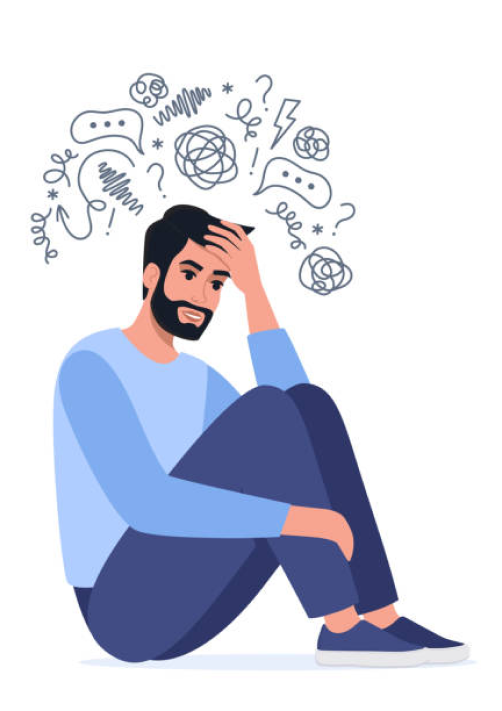ANXIETY DISORDER
Take Anxiety Test
Everyone experiences anxiety sometimes. But when anxiety feels extreme and gets in the way of your daily life, this might indicate an anxiety disorder.
While anxiety can feel overwhelming at times, there are many ways to cope. With the right tools, you can manage your anxiety and start feeling less anxious.
Keep reading to learn about the different types of anxiety disorders, symptoms and treatments, and tips to help you manage your anxiety.
Types of anxiety disorders
Anxiety refers to feelings of nervousness, fear, or worry. Most people will feel anxious before a job interview, when taking a test, or on their first day at a new job or school.
Anxiety disorders involve excessive fear, anxiety, or worries that interfere with your well-being and ability to function. For example, recurring anxious thoughts and behaviors can have a big impact on your work life, school life, hobbies, or relationships.
Anxiety disorders are defined by the situations or objects that cause your anxiety. Some anxiety disorders have different symptoms and types of negative thoughts associated with them
Types of anxiety disorders include:
Generalized anxiety disorder (GAD). The focus of your anxiety isn’t on one thing but several things when you have GAD. This could include health, social interactions, or work. These worries appear on more days than not for at least 6 months.
Panic disorder. This disorder involves recurrent and unexpected panic attacks. Panic disorder can lead to worry or stress about future panic attacks. It’s important to note that having panic attacks doesn’t always mean you have panic disorder.
Agoraphobia. This condition involves an intense fear of a situation that might be difficult to escape from. This might include open spaces, enclosed spaces, or public transport. For some people, these fears make it difficult to leave the house.
Social anxiety disorder. Previously known as social phobia, this is an intense fear of social situations or performing in front of others. The anxieties are linked with a fear of negative judgement from others, and a fear of showing signs of anxiety or embarrassment in public.
Specific phobias. Also known as simple phobias, this involves an intense fear of a certain object or situation. The fear is out of proportion with the actual danger posed. Common phobias people have involve animals, heights, flying, and injections.
Separation anxiety disorder. This condition involves intense anxiety about being separated from people you feel close to. This can affect both children and adults.
Symptoms
Anxiety disorders are characterized by strong feelings of fear or worry that impact your well-being and daily functioning. This can go from test anxiety to social anxiety.
Anxiety has both physical and mental effects. These include:
• racing thoughts
• shortness of breath
• rapid heart rate or feeling like your heart is pounding hard
• upset stomach
• dry mouth
• feeling dizzy
• feelings of dread or panic
• sweating
• tunnel vision
• feeling restless
• muscle tension
• physical weakness
• poor memory
• confusion
• trouble concentrating
• constant worry
Causes
Many factors may contribute to the development of an anxiety disorder, including:
• childhood development
• genetics
• neurobiology
• psychological factors
• personality development
• social and environmental cues
• protective factors
Treatments
For many people, anxiety treatment has two primary elements: psychotherapy (talk therapy) and medications , if indicated.
Even without professional help, you can reduce your anxiety levels by using everyday coping methods. Different methods work better for different people, so it’s worth trying out a few strategies to see what works best for you.
Everyday coping methods
Working out what’s best for you can involve some trial and error. It’s important to go at your own pace and do what feels comfortable. Then, keep doing what feels helpful for you.
Many people find that relaxation methods are a powerful tool for soothing anxiety. These include:
Deep breathing exercises. Take a few deep breaths in and out, focusing on each breath. This make you feel more grounded and in control of your body. Deep breathing can soothe the body’s stress response.
Mindfulness meditation. When you feel anxious, mindfulness can create calm and give you some breathing space. Practicing mindfulness regularly, even when you’re not feeling anxious, can provide you with the tools to bring your anxiety under control when it does arise.
Exercising regularly can also be a really helpful way to manage anxiety. If this feels difficult, try starting out gently by taking a walk, or standing up and stretching for a few minutes.
Movement and activity generates endorphins, which are our feel-good hormones. These hormones boost your mood and reduce anxiety.
For some people, caffeine and certain medications can produce anxiety symptoms or make their symptoms worse. In these cases, limiting caffeine and alcohol can help reduce anxiety.